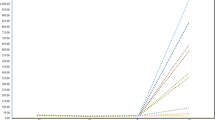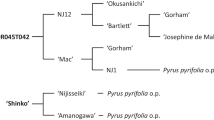Abstract
Traditionally viewed as an Andean grain crop,Chenopodium quinoa Willd. includes domesticated populations that are not Andean, and Andean populations that are not domesticated. Comparative analysis of leaf morphology and allozyme frequencies have demonstrated that Andean populations, both domesticated(quinua) and free-living(ajara), represent an exceptionally homogeneous unit that is well differentiated from allied domesticates of coastal Chile(quingua) and freeliving populations of the Argentine lowlands(C. hircinum). This pattern of relationships indicates that Andean populations represent a monophyletic crop/weed system that has possibly developed through cyclic differentiation (natural vs. human selection) and introgressive hybridization. Relative levels of variation suggest that this complex originated in the southern Andes, possibly from wild types allied withC. hircinum, with subsequent dispersal north to Colombia and south to the Chilean coast. Coastal populations were apparently isolated from post-dispersal differentiation and homogenization that occurred in the Andes. Other data point toward a center of origin in the northern Andes with secondary centers of genetic diversity subsequently developing in the southern Andes and the plains of Argentina. Comparative linkage of South American taxa, all tetraploid, with North American tetraploids of the subsection will eventually clarify this problem. While the possibility of a direct phyletic connection betweenC. quinoa and the Mexican domesticate(C. berlandieri subsp. nuttalliae,) cannot be excluded, available evidence indicates that the latter represents an autonomous lineage that is associated with the basal tetraploid, C. b. subsp.berlandieri, through var.sinuatum, whereas South American taxa show possible affinities to either var. zschackei or var.berlandieri. An extinct domesticate of eastern North America,C. b. subsp.jonesianum, represents either another instance of independent domestication, possibly from subsp. b. var.zschackei, or a northeastern outlier of subsp.nuttalliae.
Similar content being viewed by others
Literature cited
Aellen, P. 1929. Beitrag zur Systematik derChenopodium–Arten Amerikas, vorweigend auf Grund der Sammlung des United States National Museum in Washington, D.C. Feddes Repert. Spec. Nov. Regni Veg. 26:31–64, 119-160.
—. 1960.Chenopodium. Pages 533–657in G. Hegi, ed., Illustrierte Flora von Mitteleuropa, 2nd ed., vol. 3. C. Hanser, Munich.
—, and T. Just. 1943. Key and synopsis of the American species of the genusChenopodium L. Amer. Midi. Naturalist 30:47–67.
Brücher, H. 1987. The isthmus of Panama as a crossroad for prehistoric migration of domesticated plants. Geojournal 14:121–122.
Crawford, D. J. 1973. Morphology, flavonoid chemistry, and chromosome number of theChenopodium neomexicanum complex. Madroño 22:185–195.
Cusack, D. F. 1984. Quinua: grain of the Incas. The Ecologist 14:21–31.
Dostalek, J. 1987. Influence of the mode of pollination on offspring of some species of the genusChenopodium. Preslia 59:263–269.
Early, D. K. 1979. Cultivation and uses of amaranth in contemporary Mexico. Pages 22–29in J. N. Cole, ed., Amaranth from the past for the future. Rodale Press, Emmaus, PA.
Etchevers, G. G. 1980. Composición química de algunas leguminosas y Chenopodiâceas de la Provincia de ~Nubie. Cienc. Invest. Agrar. (Chile) 7:191–196.
— 1981 Efecto de la fecha de siembra, distancia entre surcos y ecotipos sobre el rendimiento y comportamiento de quinoa (Chenopodium quinoa Willd.) in Chilian. Cienc. Invest. Agrar. (Chile) 8:19–26.
Fritz, G. 1984. Identification of cultigen amaranth and chenopod from rocksheiter sites in northwest Arkansas. Am. Antiquity 49:558–572.
Gilmore, M. R. 1931. Vegetal remains of the Ozark Bluff Dweller culture. Pap. Michigan Acad. Sci. 14:83–103.
Harlan, J. R. 1965. The possible role of weed races in the evolution of cultivated plants. Euphytica 14:173–176.
Heiser, C. B. 1985. Of plants and people. University of Oklahoma Press, Norman.
Hunziker, A. T. 1943. Los especies alimenticias deAmaranthus y Chenopodium cultivadas por los Indios de America. Revista Argent. Agron. 30:297–353.
—. 1952. Los pseudocereales de la agriculture indigena de América. ACME Agency, Buenos Aires.
—, and A. M. Planchuelo. 1971. Sobre un neuvo hallazgo deAmaranthus caudatus en tumbas indigena de Argentina. Kurtziana 6:63–67.
Iljin, M. M. 1936. Chenopodiaceae. Pages 2–354in V. L. Komarov, ed., Flora URSS (Centrospermae). Akademiia Nauk, Leningrad.
Kirkpatrick, K. J., and H. D. Wilson. 1988. Interspecific gene flow inCucurbita: C. texana vs.C. pepo. Amer. J. Bot. 75:519–527.
Looser, G. 1943.Chenopodium quinoa: un cultivo que desaparece de Chile. Revista Argentina de Agronomia 10:111–113.
Partap, T., and P. Kapoor. 1985a. The Himalayan grain chenopods. I. Distribution and ethnobotany. Agric. Ecosystems Environ. 14:185–199.
—, and —. 1985b. The Himalayan grain chenopods. II. Comparative morphology. Agric. Ecosystems Environ. 14:201–220.
Risi, J. C., and N. W. Galwey. 1984. TheChenopodium grains of the Andes: Inca crops for modern agriculture. Adv. Appl. Biol. 10:145–216.
Safford, W. E. 1917.Chenopodium nuttalliae, a food plant of the Aztecs. J. Wash. Acad. Sci. 8:521–527.
Sauer, C. O. 1950. Cultivated plants of South and Central America. Pages 495–497in J. J. Steward, ed., Handbook of the South American Indians. Bureau of American Ethnology Bull. 143. Part 6.
—. 1952. Agricultural origins and dispersals. American Geographical Society, New York.
—. 1965. Cultural factors in plant domestication in the New World. Euphytica 14:301–306.
Scott, A. J. 1978. A review of the classification ofChenopodium L. and related genera (Chenopodiaceae). Bot. Jahrb. Syst. 100:205–220.
Simmonds, N. W. 1965. The grain chenopods of the tropical American highlands. Econ. Bot. 19: 223–235.
—. 1976a. Quinoa and relatives. Pages 29–30in N. W. Simmonds, ed., Evolution of crop plants. Longman, New York.
—. 1976b. Potatoes. Pages 279–283in N. W. Simmonds, ed., Evolution of crop plants. Longman, New York.
Smith, B. G. 1985.Chenopodium berlandieri ssp.jonesianum: evidence for a Hopewellian domesticate from Ash Cave, Ohio. Southeastern Archaeology 4:107–133.
—. 1986. The archaeology of the southeastern United States: from Dalton to de Soto, 10,500 B.P. Pages 1–92in F. Wendorf and A. E. Close, eds., Advances in world archaeology 5. Academic Press, Orlando, FL.
—. 1987a. The economic potential ofChenopodium berlandieri in prehistoric eastern North America. J. Ethnobiol. 7:29–54.
-. 1987b. The independent domestication of indigenous seed-bearing plants in eastern North America. Pages 3–47in W. F. Keegan, ed., Emergent horticultural economies of the eastern woodlands. Southern Illinois University of Carbondale Center for Archaeological Investigations.
—. 1989. Origins of agriculture in eastern North America. Science 246:1566–1571.
—, and V. A. Funk. 1985. A newly described subfossil cultivar ofChenopodium (Chenopodiaceae). Phytologia 57:445–448.
Tapia, M. 1979. Historia y distributión geográfica. Pages 11–19in M. E. Tapia, ed.,Quinua ykañiwa: cultivos andinos. CIID, Bogotá.
—, H. Gandarillas, S. Alandia, A. Cardozo, and A. Mujica. 1979. Quinua y kañiwa: cultivos andinos. CIID, Bogotá.
Wahl, H. A. 1954. A preliminary study of the genusChenopodium in North America. Bartonia 27: 1–46.
Walters, T. W. 1988a. Relationship between isozymic and morphologic variation in the diploidsChenopodium fremontii, C. neomexicanum, C. palmeri, andC. watsonii. Amer. J. Bot. 75:97–105.
— 1988b. Electrophoretic evidence for the evolutionary relationship of the tetraploidChenopodium berlandieri to its putative diploid progenitors. Selbyana 10:36–55.
Weeden, N. F., J. J. Doyle, and M. Lavin. 1989. Distribution and evolution of a glucosephosphate isomerase duplication in the Leguminosae. Evolution 43:1637–1651.
West, G. C. 1967. Nutrition of tree sparrows during winter in central Illinois. Ecology 48:58–67.
Williams, J. T., and J. L. Harper. 1965. Seed polymorphism and germination. I. The influence of nitrates and low temperatures on the germination ofChenopodium album. Weed Res. 5:141–150.
Wilson, H. D. 1976. Genetic control and distribution of leucine aminopeptidase in the cultivated chenopods and related weed taxa. Biochem. Genet. 14:913–919.
—. 1980. Artificial hybridization among species ofChenopodium sectionChenopodium. Syst. Bot. 5:253–263.
—. 1981a. Genetic variation among tetraploidChenopodium populations of southern South America (sect.Chenopodium subsect.Cellulata). Syst. Bot. 6:380–398.
—. 1981b. DomesticatedChenopodium of the Ozark Bluff Dwellers. Econ. Bot. 35:233–239.
—. 1985.Chenopodium quinoa Willd.: variation and relationships in southern South America. Nat. Geog. Soc. Res. Repts. 19:711–721.
—. 1988a. Allozyme variation and morphological relationships ofChenopodium hircinum (s.l.). Syst. Bot. 13:215–228.
—. 1988b. Quinua biosystematics I: domesticated populations. Econ. Bot. 42:461–477.
—. 1988c. Quinua biosystematics II: free-living populations. Econ. Bot. 42:478–494.
—, S. C. Barber, and T. W. Walters. 1983. Loss of duplicate gene expression in tetraploidChenopodium. Biochem. Syst. Ecology 11:7–13.
—, and C. B. Heiser, Jr. 1979. The origin and evolutionary relationships of ‘Huauzontle’ (Chenopodium nuttalliae Saffbrd), domesticated chenopod of Mexico. Amer. J. Bot. 66:198–206.
Wood, R. W. 1988. Quinoa–the supergrain. Japan Publications, Tokyo.
Author information
Authors and Affiliations
Rights and permissions
About this article
Cite this article
Wilson, H.D. Quinua and Relatives (Chenopodium sect.Chenopodium subsect.Celluloid). Econ Bot 44 (Suppl 3), 92–110 (1990). https://doi.org/10.1007/BF02860478
Issue Date:
DOI: https://doi.org/10.1007/BF02860478




